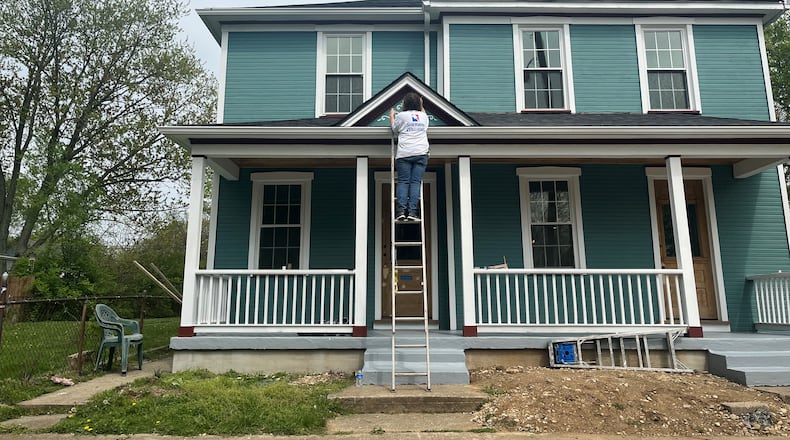“It’s going to take a group effort to start moving the ship back in the right direction,” said Todd Kinskey, Dayton’s director of planning, neighborhoods and development.
He later added, “The main issue is what do we control as a city, and how do we spend and apply the resources that we have in a way that we are all on the same kind of wavelength.”
Dayton has cheap housing, but a lot of it is outdated, substandard and in disrepair, and some people are paying far more than they should for poor-quality housing.
By 2026, the city of Dayton will need more than 3,800 new rental units and 4,600 new units that are for sale to meet demand, according to a recent housing needs assessment funded by a local nonprofit group.
Dayton recently convened a “housing roundtable” that included representatives of land use boards, foundations, public agencies, nonprofits, financial institutions, community development corporations, policy groups, builders, real estate groups, city staff and other stakeholders.
Some participants have joined three working groups focused on housing development, the preservation of affordable housing and housing support programs.
Collective model
The committees are expected to produce recommendations about the best places to put future housing; how the city should use its resources, funds and incentives to preserve and expand the housing supply; and how to improve code enforcement practices.
“This is a very complex and challenging problem to solve,” said Dayton City Manager Shelley Dickstein. “The best research tells you bringing in these large collaborations of critical thinkers — that’s the best practice.”
Other recommendations could guide city decisions about what to do with the nearly 6,000 acres of land and property that it owns or that is in the hands of its “friendly partners,” officials said.
Land control matters a great deal, Dickstein said, which was evident after talking with officials in other U.S. cities about the things they wish they did differently to avoid their affordable housing problems.
Dayton already has done a great deal of data analysis to glean valuable information about its neighborhoods, such as housing quality and conditions, levels of homeownership and concentrations of subsidized and non-subsidized housing units, city officials said.
The working groups might come up with recommendations intended to prevent oversaturation of subsidized units, which has been a cause of concern among some community members.
The city also is thinking about expanding its code enforcement options to possibly include a civil administrative process, partly to deal with problems with properties owned by LLCs.
Some cities have created affordable housing trust funds, and working group members are expected to explore that as an option.
Credit: Cornelius Frolik
Credit: Cornelius Frolik
Diverse housing needs
Dayton needs diverse socioeconomic neighborhoods, Dickstein said, adding that she hopes the “collective model” will identify the best locations for permanent affordable housing and what can be done if some housing that is currently affordable doesn’t stay that way.
The groups are expected to look at best housing practices in other communities across the nation, Dickstein said, and they may work on potential solutions to housing issues that can get very technical, like figuring out what to do with properties when their tax abatements expire.
Group recommendations will be drafted into policies that will be shared with the Dayton City Commission and the community to gather feedback, Dickstein said, and those recommendations should be completed by late summer.
The whole process could take six to nine months. It began in March.
Partnerships
Many things about Dayton’s housing market and supply are outside of the the city’s control, Dickstein said, but it still has significant influence, especially through its relationships and partnerships.
New housing policies should give more clarity to the city’s private and nonprofit partners about what kinds of housing it wants and needs in its neighborhoods, said Torey Hollingsworth, director of the Dayton City Commission Office, who will lead the subcommittee on housing support programs.
Quality affordable housing is needed near job centers, amenities and along transit routes, officials said, and diverse housing choices are required to attract new residents and retain them when they grow their families or get older and want to downsize.
Also, many people who live outside of Dayton but who used to work in the city are now working from home in the wake of the COVID crisis, which is expected to lead to large income tax revenue losses for the city.
Credit: Cornelius Frolik
Credit: Cornelius Frolik
Dayton needs more housing for professionals who expect to work from home for the foreseeable future.
“What we can do is help create better market conditions that allow for the development of housing that might appeal to people who otherwise might choose to live somewhere else,” Hollingsworth said.
The need for affordable housing is increasing as the population and housing stock ages, and more than 85% of the housing stock is more than 50 years old, said Amy Radachi, president and CEO of Rebuilding Together Dayton, who is a member of the subcommittee focused on housing support programs.
“At any given time, Rebuilding Together Dayton has at least 80 to 100 Montgomery County senior homeowners in the pipeline seeking repairs and modifications so they may age in place,” she said. “Our biggest challenge is securing the funding to meet the needs of those who wish to remain in their homes.”
About the Author



